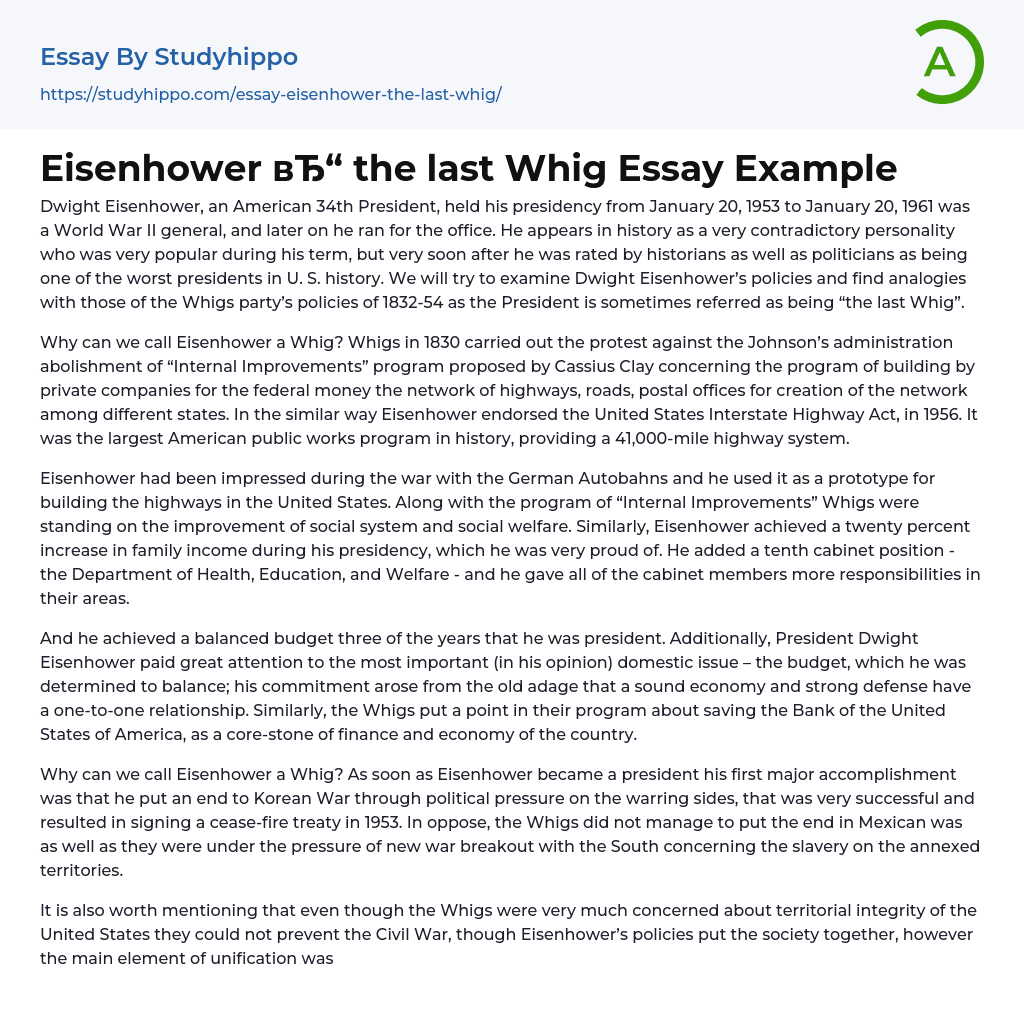Dwight Eisenhower, who served as the 34th President of the United States from January 20, 1953 to January 20, 1961, was a World War II general before he entered politics. His presidency and persona are often seen as complex and multifaceted. Despite being highly respected during his time in office, subsequent evaluations by historians and political figures have frequently placed him amongst the least effective U.S presidents. Our study aims to thoroughly examine Eisenhower's policies and contrast them with those upheld by the Whigs party from 1832-54; this is because Eisenhower is sometimes referred to as "the last Whig".
Eisenhower's support for the United States Interstate Highway Act in 1956 puts him in line with the Whig Party, reminiscent of those from the 1830s. These earlier Whigs were opposed when Johnson's administration ended the "Internal Improvements" program.
...Cassius Clay advocated for this initiative that aimed to leverage federal resources for constructing infrastructure such as highways, roads and postal offices via private firms to improve inter-state communication. In a similar vein, Eisenhower's backing of the Highway Act led to the creation of an expansive highway system covering over 41,000 miles, which is hailed as America's largest public works project ever.
During the war, Eisenhower drew inspiration from the German Autobahns and used them as a blueprint for constructing highways across America. His participation in the Whig party's 'Internal Improvements' initiative underscored his commitment to improving societal infrastructure and welfare. Under his leadership, there was a significant twenty percent rise in family income - a feat he held high regard for. Additionally, he augmented his cabinet by incorporating The Department of Health, Education
and Welfare as its tenth division, thereby allotting more responsibilities to each cabinet member within their distinct sectors.
Throughout his tenure, he managed to keep the budget balanced for three straight years. President Dwight Eisenhower had a particular commitment to what he viewed as a vital domestic matter - securing a balanced budget; this dedication arose from the mainstream belief that a strong economy is fundamental to dependable defense. Likewise, maintaining the Bank of the United States of America was considered an indispensable element in the Whigs' plan, given its significance in guaranteeing economic and financial stability across the country.
How does Eisenhower connect with the Whigs? When Eisenhower assumed the presidency, his inaugural achievement was ending the Korean War by exerting political influence over the fighting factions - an action that yielded successful results in form of a truce agreement inked in 1953. However, in comparison, the Whigs failed to accomplish a similar feat during the Mexican War. Furthermore, they faced looming threats of another conflict with the South over slave-owning issues in newly annexed territories.
Despite the Whigs' strong commitment to safeguarding the geographical wholeness of the United States, they failed to prevent the Civil War. On the other hand, Eisenhower's strategies were successful in significantly consolidating society, largely driven by widespread fear of communism or what is termed as "red scare". It's also worth noting that Eisenhower's attention was primarily directed at foreign and defense policies, showing less interest in domestic issues. Conversely, global affairs held little importance for the Whigs whose priority was to uphold internal tranquility within American society.
Eisenhower, working alongside the Whigs, overlooked civil
rights matters especially those pertaining to slavery and the African American civil rights movements. It's important to highlight that there were similarities between President Eisenhower's political maneuvers and those of the Whig party from 1832 to 1854 in relation to societal advancement. This included efforts such as expanding road and highway systems, advocating for social welfare, and improving economic and financial frameworks. However, both groups evaded discussing the civil rights movements during their respective eras, even though they had different perspectives on foreign affairs.
- Federal government essays
- Armed Forces essays
- Confederate States Of America essays
- Federal Government Of The United States essays
- Fourteenth Amendment To The United States Constitution essays
- Governance essays
- Parliament essays
- Politics essays
- Jurisdiction essays
- Bureaucracy essays
- Separation Of Powers essays
- Congress essays
- President essays
- United States Congress essays
- Non-Commissioned Officer essays
- Appeal essays
- Revenge essays
- Corporate Governance essays
- Public Service essays
- Income Tax essays
- Supply essays
- Red Cross essays
- Democracy essays
- State essays
- Liberty essays
- Absolutism essays
- Reform essays
- Republic essays
- John Marshall essays
- Bourgeoisie essays
- Developed Country essays
- Elections essays
- International Relations essays
- Left-Wing Politics essays
- Monarchy essays
- Political Corruption essays
- Political Party essays
- Political Science essays
- Sovereign State essays
- United Nations essays
- World Trade Organization essays
- Contras essays
- Dictatorship essays
- Foreign policy essays
- Monarch essays
- Corruption essays
- Foreign essays
- Democratic Party essays
- European Union essays
- President Of The United States essays




